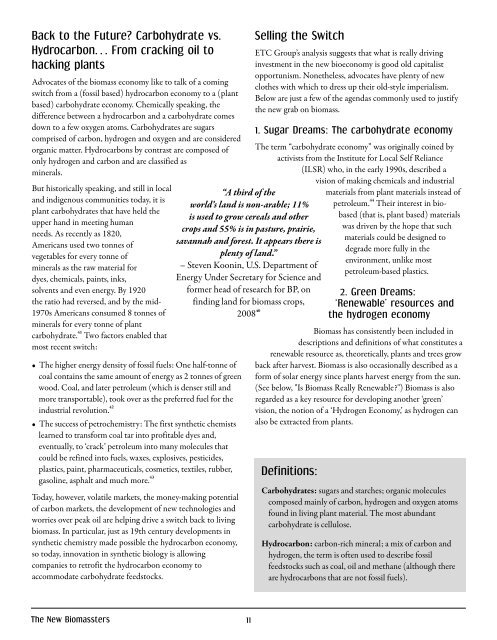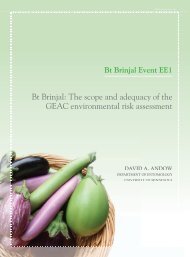English - pdf - 2145 Kb - Biosafety Information Centre
English - pdf - 2145 Kb - Biosafety Information Centre
English - pdf - 2145 Kb - Biosafety Information Centre
- No tags were found...
Create successful ePaper yourself
Turn your PDF publications into a flip-book with our unique Google optimized e-Paper software.
Back to the Future? Carbohydrate vs.Hydrocarbon… From cracking oil tohacking plantsAdvocates of the biomass economy like to talk of a comingswitch from a (fossil based) hydrocarbon economy to a (plantbased) carbohydrate economy. Chemically speaking, thedifference between a hydrocarbon and a carbohydrate comesdown to a few oxygen atoms. Carbohydrates are sugarscomprised of carbon, hydrogen and oxygen and are consideredorganic matter. Hydrocarbons by contrast are composed ofonly hydrogen and carbon and are classified asminerals.But historically speaking, and still in localand indigenous communities today, it isplant carbohydrates that have held theupper hand in meeting humanneeds. As recently as 1820,Americans used two tonnes ofvegetables for every tonne ofminerals as the raw material fordyes, chemicals, paints, inks,solvents and even energy. By 1920the ratio had reversed, and by the mid-1970s Americans consumed 8 tonnes ofminerals for every tonne of plantcarbohydrate. 41 Two factors enabled thatmost recent switch:• The higher energy density of fossil fuels: One half-tonne ofcoal contains the same amount of energy as 2 tonnes of greenwood. Coal, and later petroleum (which is denser still andmore transportable), took over as the preferred fuel for theindustrial revolution. 42• The success of petrochemistry: The first synthetic chemistslearned to transform coal tar into profitable dyes and,eventually, to ‘crack’ petroleum into many molecules thatcould be refined into fuels, waxes, explosives, pesticides,plastics, paint, pharmaceuticals, cosmetics, textiles, rubber,gasoline, asphalt and much more. 43Today, however, volatile markets, the money-making potentialof carbon markets, the development of new technologies andworries over peak oil are helping drive a switch back to livingbiomass. In particular, just as 19th century developments insynthetic chemistry made possible the hydrocarbon economy,so today, innovation in synthetic biology is allowingcompanies to retrofit the hydrocarbon economy toaccommodate carbohydrate feedstocks.Selling the Switch“A third of theworld’s land is non-arable; 11%is used to grow cereals and othercrops and 55% is in pasture, prairie,savannah and forest. It appears there isplenty of land.”– Steven Koonin, U.S. Department ofEnergy Under Secretary for Science andformer head of research for BP, onfinding land for biomass crops,2008 40 Definitions:ETC Group’s analysis suggests that what is really drivinginvestment in the new bioeconomy is good old capitalistopportunism. Nonetheless, advocates have plenty of newclothes with which to dress up their old-style imperialism.Below are just a few of the agendas commonly used to justifythe new grab on biomass.1. Sugar Dreams: The carbohydrate economyThe term “carbohydrate economy” was originally coined byactivists from the Institute for Local Self Reliance(ILSR) who, in the early 1990s, described avision of making chemicals and industrialmaterials from plant materials instead ofpetroleum. 44 Their interest in biobased(that is, plant based) materialswas driven by the hope that suchmaterials could be designed todegrade more fully in theenvironment, unlike mostpetroleum-based plastics.2. Green Dreams:‘Renewable’ resources andthe hydrogen economyBiomass has consistently been included indescriptions and definitions of what constitutes arenewable resource as, theoretically, plants and trees growback after harvest. Biomass is also occasionally described as aform of solar energy since plants harvest energy from the sun.(See below, "Is Biomass Really Renewable?") Biomass is alsoregarded as a key resource for developing another ‘green’vision, the notion of a ‘Hydrogen Economy,’ as hydrogen canalso be extracted from plants.Carbohydrates: sugars and starches; organic moleculescomposed mainly of carbon, hydrogen and oxygen atomsfound in living plant material. The most abundantcarbohydrate is cellulose.Hydrocarbon: carbon-rich mineral; a mix of carbon andhydrogen, the term is often used to describe fossilfeedstocks such as coal, oil and methane (although thereare hydrocarbons that are not fossil fuels).The New Biomassters 11











